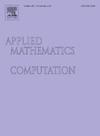Weak degeneracy of the square of K4-minor free graphs
IF 3.5
2区 数学
Q1 MATHEMATICS, APPLIED
引用次数: 0
Abstract
A graph G is called weakly f-degenerate with respect to a function f from to the non-negative integers, if every vertex of G can be successively removed through a series of valid Delete and DeleteSave operations. The weak degeneracy is defined as the smallest integer d for which G is weakly d-degenerate, where d is a constant function. It was demonstrated that one plus the weak degeneracy can act as an upper bound for list-chromatic number and DP-chromatic number. Let if , and if . In this paper, we prove that for every -minor free graph G, , which implies that is -choosable and -DP-colorable. This work generalizes the result obtained by Lih et al. in [Discrete Mathematics, 269 (2003), 303-309] and Hetherington et al. in [Discrete Mathematics, 308 (2008), 4037-4043].
求助全文
约1分钟内获得全文
求助全文
来源期刊
CiteScore
7.90
自引率
10.00%
发文量
755
审稿时长
36 days
期刊介绍:
Applied Mathematics and Computation addresses work at the interface between applied mathematics, numerical computation, and applications of systems – oriented ideas to the physical, biological, social, and behavioral sciences, and emphasizes papers of a computational nature focusing on new algorithms, their analysis and numerical results.
In addition to presenting research papers, Applied Mathematics and Computation publishes review articles and single–topics issues.

 求助内容:
求助内容: 应助结果提醒方式:
应助结果提醒方式:


